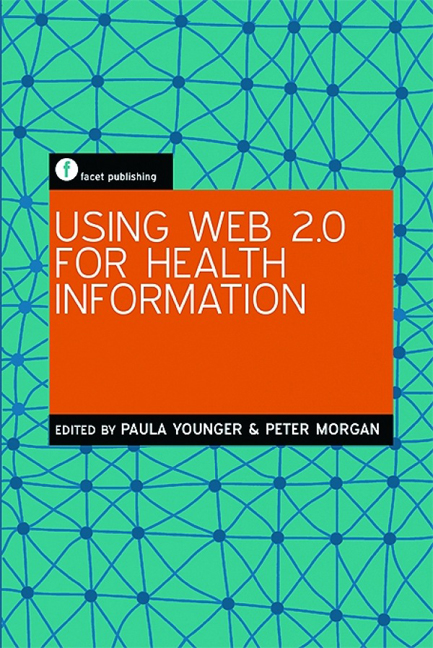Book contents
- Frontmatter
- Contents
- Preface
- Acknowledgements
- Contributors
- Glossary
- Introduction
- Part 1 The basics
- Part 2 Web 2.0 and the implications for health information
- Part 3 Web applications in health information provision: some practical examples
- 9 Web 2.0 in health libraries
- 10 RSS (Really Simple Syndication): helping faculty and residents stay up to date
- 11 Using mashups in health information provision
- 12 Twitter in a hospital library
- 13 Using Web 2.0 to facilitate staff development
- Part 4 The future
- Index
13 - Using Web 2.0 to facilitate staff development
from Part 3 - Web applications in health information provision: some practical examples
Published online by Cambridge University Press: 08 June 2018
- Frontmatter
- Contents
- Preface
- Acknowledgements
- Contributors
- Glossary
- Introduction
- Part 1 The basics
- Part 2 Web 2.0 and the implications for health information
- Part 3 Web applications in health information provision: some practical examples
- 9 Web 2.0 in health libraries
- 10 RSS (Really Simple Syndication): helping faculty and residents stay up to date
- 11 Using mashups in health information provision
- 12 Twitter in a hospital library
- 13 Using Web 2.0 to facilitate staff development
- Part 4 The future
- Index
Summary
Introduction
Recent years have seen an increasing imperative for health librarians and information professionals to demonstrate that they possess, and use, mechanisms for ‘keeping current’ (Health Executive Advisory Group, 2004; Cunningham, 2010). As the speed of organizational and technical change becomes increasingly rapid, the requisite skill base covers an ever wider range of competencies (captured in the acronym COMPLIANT). Increasing user expectations, coupled with demands for quality, accountability and efficacy of practice, further emphasize the need to demonstrate strategies for periodic refreshment of skills and knowledge (Lacey and Booth, 2003). At the same time, conferences and workshops, traditional routes for acquiring such updates, are becoming less accessible as budgetary constraints and lack of time, combined with the need to provide continuity of front-line service, limit opportunities for staff to attend external training courses. E-learning, delivered via the web and facilitated by an increasing array of Web 2.0 technologies, offers the prospect of delivering staff development to library staff in the workplace (Ayiku et al., 2005).
Requirements for staff development
Our review of workplace-based e-learning identified five major themes: (1) peer communication, (2) flexibility, (3) support, (4) knowledge validation and (5) course presentation and design (Booth et al., 2009). The implications of these themes are as follows:
1 E-learners working in isolation typically need to be able to interact with other learners and to receive social support for learning.
2 Pressures of work make it more difficult to establish a routine for learning; deadlines for interaction or for assessment must be as flexible as possible.
3 Workplace-based e-learners lack the reassurance that is provided by face-to-face interaction with teaching staff and require speedy and efficient support in response to questions.
4 Mechanisms for checking knowledge are essential if e-learners are to verify their own learning and understanding throughout the learning module, not just at the end of the module.
5 Course materials must be well presented and easy to navigate, particularly as workplace learners typically learn opportunistically, in bite-sized chunks, rather than enjoying the luxury of protected study time.
How Web 2.0 measures up
It is immediately apparent that Web 2.0 technology has much to offer in meeting the five identified needs of workplace-based learners rehearsed above. The interactivity and ease of use of blog and wiki technologies facilitate communication with (Grassley and Bartoletti, 2009) and peer support from fellow learners (Moen et al., 2009).
- Type
- Chapter
- Information
- Using Web 2.0 for Health Information , pp. 131 - 138Publisher: FacetPrint publication year: 2011



